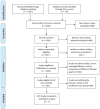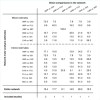Clinical efficacy and safety of antifungal drugs for the treatment of Candida parapsilosis infections: a systematic review and network meta-analysis
- PMID: 34633919
- PMCID: PMC8604171
- DOI: 10.1099/jmm.0.001434
Clinical efficacy and safety of antifungal drugs for the treatment of Candida parapsilosis infections: a systematic review and network meta-analysis
Abstract
Antifungal drugs have already been established as an effective treatment option for Candida parapsilosis infections, but there is no universal consensus on the ideal target for clinical efficacy and safety of antifungal drugs for the treatment of C. parapsilosis infections. Few studies have directly compared the efficacies of antifungal drugs for the treatment of C. parapsilosis infections. We hypothesize that different antifungal drugs offer differing clinical efficacy and safety for the treatment of C. parapsilosis infections. We performed a comprehensive network meta-analysis on different strategies for C. parapsilosis infection treatment and compared the clinical efficacy and safety of antifungal drugs as interventions for C. parapsilosis infections. The Cochrane Database of Systematic Reviews, Medline, Embase, PubMed, Web of Science, China National Knowledge Infrastructure (CNKI), Technology of Chongqing VIP database, Wan Fang Data, and SinoMed databases were searched to identify appropriate randomized trials. Among the extracted C. parapsilosis cases, the survival and death rates with treatment of C. parapsilosis infection were compared among groups treated with different antifungal drugs. According to the evidence-network analysis, echinocandins were a better choice than other drugs for treating C. parapsilosis infections, and more importantly, caspofungin showed a more preferable effect for decreasing the risk of 30 day mortality. In conclusion, this study systematically evaluated the effectiveness and safety of antifungal drugs for the purpose of helping clinicians choose the most appropriate antifungal drugs. Future studies with larger samples are needed to evaluate the effects of patient factors on the clinical efficacy and safety of antifungal drugs for C. parapsilosis infections.
Keywords: Candida parapsilosis; antifungal drugs; clinical efficacy; meta-analysis; safety.
Conflict of interest statement
The authors declare that there are no conflicts of interest.
Figures








References
-
- Almirante B, Rodríguez D, Cuenca-Estrella M, Almela M, Sanchez F, et al. Epidemiology, risk factors, and prognosis of Candida parapsilosis bloodstream infections: case-control population-based surveillance study of patients in Barcelona, Spain, from 2002 to 2003. J Clin Microbiol. 2006;44:1681–1685. doi: 10.1128/jcm.44.5.1681-1685.2006. - DOI - PMC - PubMed
-
- Wang H, Xiao M, Chen SC, Kong F, Sun ZY, et al. In vitro susceptibilities of yeast species to fluconazole and voriconazole as determined by the 2010 National China Hospital Invasive Fungal Surveillance Net (CHIF-NET) study. J Clin Microbiol. 2012;50:3952–3959. doi: 10.1128/jcm.01130-12. - DOI - PMC - PubMed
Publication types
MeSH terms
Substances
LinkOut - more resources
Full Text Sources
Medical

